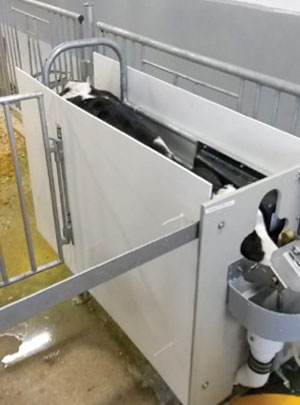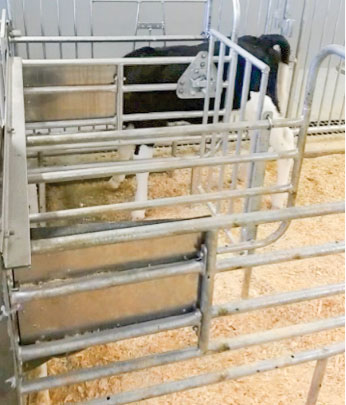Group housing of dairy calves is becoming more popular, and so are automatic milk feeders. Some of the reasons producers choose to use this new technology include addressing calf health and welfare concerns, and reducing labour while still providing calves with enough milk to reach their growth potential.
Automatic milk feeders also offer producers the option to monitor each calf’s milk intake and thus more easily detect and identify calves that may be sick thanks to alarms integrated in the system.
One of the challenges producers face with automatic milking feeders is teaching calves to interact with and learn to use the feeders. Some calves have more difficulty learning to use them, and this can cause a decrease in milk consumption and potentially lead to slow-growing or sick calves.
 Calf stall designs for automatic feeders. Courtesy photos.
Calf stall designs for automatic feeders. Courtesy photos.
A study by the University of Guelph (financed under the Dairy Research Cluster program) aimed to compare how stall design and training methods affected calf interactions with the automatic milk feeders. Tanya Wilson, the graduate student leading the project under the supervision of Dr. Derek Haley, compared two types of stalls commonly installed with the feeders.
The goal was to see whether calves learned to use one type better than the other. Their initial hypothesis was that calves would take a longer time approaching solid stalls constructed of white plastic (Photo 1) without some type of assistance compared to a metal-gated stall design (Photo 2).

They enrolled 147 Holstein calves from the Elora Livestock Research and Innovation Center – Dairy facility. The calves were at least 4 days old when they were introduced to group housing with automatic milk feeders.
They were assigned to one type of stall design and then trained to use the automatic milk feeders by the researchers by allowing them to suck on the trainer’s fingers and guiding them to the teat on the feeder. Some calves were trained on feeders with solid stalls, and others were trained on metal-gated stalls.
Researchers recorded the behaviour of calves for three days using video cameras and then used the data from the feeders to determine how long calves took to approach the feeders and how often and how much they drank.
What they found was that calves assigned to the gated-stall design took twice as long to approach the feeding stall compared to calves assigned to the solid sides.
They took longer to lick or bite at the nipple, and it took them more time to drink voluntarily from the metal-gated feeders. Calves using the feeders with a solid-stall design learned much quicker to enter and use the nipple.
Overall, calves drank anywhere from 8 to 34 litres in the 72 hours they were observed. The researchers also found how easily a calf learned during their initial training interacted with stall design and affected milk intake in calves. Those trained on the gated-style feeder consumed an average of 3.18 litres less than calves trained on the solid-style feeder.
Thanks to this study, researchers have some evidence that specific features of automatic milk feeders can impact how well calves learn to use them, which in turn impacts how much milk they consume, with potential repercussions on health and welfare.
Producers should be aware how stall design might affect their efforts for calf rearing and be mindful some calves may need more training for a more successful transition to feeding.
Dairy Research for a Healthy World
Dairy Farmers of Canada (DFC) is the national policy, lobbying and promotional organization representing Canada’s farmers. DFC works to support sustainable dairy production; facilitate solutions to provincial/national challenges; provide credible research of dairy products on a national basis; and create innovative ways to grow the market.








